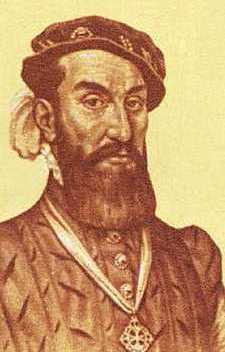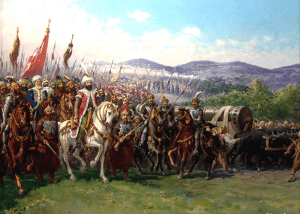The stories of the Spanish conquistadors, of men that believed themselves to be conquerors fighting and exploring for God and gold, are well known. While many of those conquistadors may have seen themselves as bringing civilization to a savage new land, there are those who would argue that this is an incorrect way to view the conquistadors. Instead, they would claim that the conquistadors were encroaching on other people’s culture and religion. One would-be conquistador ended up having a much different experience than most, an experience so different that it forced him to view the Native Americans in a new light, so much so that he eventually advocated for them. This man’s name was Alvar Nunez Cabeza de Vaca.
Cabeza de Vaca was born to a Spanish noble family in 1492. When he was young, his parents died, and he was forced to live with some other relatives. In 1521, he joined the army as an officer after distinguishing himself during military conflict in Italy. In 1527, Cabeza de Vaca embarked on an expedition to explore modern-day Florida, one led by Pánfilo de Narváez. His role in this expedition was that of treasurer for the colony.1 In addition to this, he was also ordered to let the king know of any injustices done by the Spaniards to the Native Americans. The nature of his duty did not change the way that Cabeza de Vaca viewed the Native Americans. At the beginning of the expedition, he still viewed them mainly as savages that were primarily in opposition to Spanish goals. Any respect, if any, that he gave to them was purely that of a rival in regards to their fighting ability.2 This initial attitude would end up standing in very stark contrast to the way that Cabeza de Vaca would eventually come to view them.

The beginning of the Narváez expedition was not off to a great start. Narváez imagined himself as the next Cortez and wanted to follow his example and find a city full of gold. In order to do this, Narváez had decided to pursue rumors of a city of gold, known to the natives only as “Apalachee,” instead of staying closer to the shoreline and their supplies. Narváez was hoping that he would be able to make an endless amount of wealth by conquering this civilization, but when he finally arrived on the shore, all that he and his men found was a small Native American village.3 After this accident, the expedition attempted to meet up with their ship to resupply, but the ship never arrived. It was then that Narváez decided that the crew would make their own ships and sail towards Mexico, hoping to link up with any Spanish forces in the area.4 At this point in the expedition, many of the remaining members, including Cabeza de Vaca, were convinced that their deaths were close and that their situation was dire. At one point, Narváez himself decided to abandon the other ships and survivors in favor of saving his skin. This would be the last time that Cabeza de Vaca, or anyone, would see the would-be conquistador. At the end of it all, there ended up being less than one hundred men left in the expedition, and they all eventually landed on an island that they decided to call “Malhado,” or “Misfortune.” Today, we now know this area as Galveston Island.5
It was on this island that Cabeza de Vaca first encountered the Native Americans in a new light. It was here that a group of Native Americans provided food and shelter to Cabeza de Vaca and his company. Not all of the members of the expedition took advantage of the kindness that was shown to them, however. While many were unable to trust the Native Americans, it was his willingness to trust the Native Americans that most likely saved Cabeza de Vaca’s life, as most of those who did not take their offer ended up dead. After spending the winter on the island, there were only sixteen remaining members of the expedition.6 The entire scenario was a new experience for Cabeza de Vaca, as the only way he had ever viewed the Native Americans before was as rivals. But, much to his amazement, they showed undying compassion and empathy for a group of men that they did not know. Although he originally thought that rescue was coming within a year, Cabeza de Vaca’s experience on the small island was just the beginning of what would happen to him while he lived with the Native Americans.

Cabeza de Vaca would go on to live on Malhado for about four more years while serving as a physician and trader to the tribes there. He realized that his only real chance for survival during this time was to make himself useful to the tribe. Although he had originally refused to become a healer, due to the fact that he viewed the Native American way of healing similar to idolatry, he eventually caved and started to learn their ways of healing due to necessity. He would go on to learn much about Native American culture, not because he was curious, but rather, he was forced to so in order to survive. He learned Native American languages, customs, and what items were valuable to the Native American lifestyle.7 Learning all of these skills ultimately allowed Cabeza de Vaca to survive his experience on Malhado. Over the years, Cabeza de Vaca had to get a new understanding of Native American culture as he was exposed to parts of their lives that he had never even bothered to think about before. This is also when Cabeza de Vaca most likely began embracing the different culture. When he got the opportunity, Cabeza de Vaca focused on writing many of his observations about the Native Americans, mainly on how they worked as a group and not on their individual lives. Indeed, he focused on what they did as a culture and economically above all else. This was most likely the result of the lens of mercantilism through which he often viewed the world, as it was one of the prevailing economic policies in Europe and the region that he was from.8
During his four years there, Cabeza de Vaca also met up with a few of his fellow members from the expedition that were doing similar work with other tribes, Dorantes, Estevanico, and Castillo. These three men were his main connections to his life before living in Malhado. Eventually, Cabeza de Vaca and these men decided on a gamble to leave the island in order to escape from the roles that they had been forced into during their time with the tribes. They made their escape, and, after a few days, were welcomed by a tribe on the condition that they help the tribe as healers. This predicament simply placed the men in the same situation they were in earlier. Nevertheless, they worked as healers to ensure their survival, and these men attributed any of the healing that they performed to God, as they themselves regarded any healing as a miracle.9 It was around this time that Cabeza de Vaca truly seemed to have become sympathetic to the Native Americans. Although he became genuinely worried about their well-being, he still often took offers of wealth from the tribe, and later painted himself and the other Spaniards as saviors to the Native Americans.10
Cabeza de Vaca and the others eventually found themselves well-respected by the Native Americans, and they used that fact to their advantage. In addition to accepting gifts from the tribe, they also asked the Native Americans to bring them to certain places that they wished to go. This may have started as manipulation, but after a while, Cabeza de Vaca focused on using this newfound respect to teach the Native Americans about God.11 Cabeza de Vaca and his compatriots continued to do this until they encountered a group of Spaniards near Mexico. When they finally made contact, Cabeza de Vaca quickly realized that there was a fundamental difference in the way that the Native Americans perceived him and how they perceived the other Spaniards. That is, they regard him as a man who gives back as opposed to one who takes. He also noticed that his view of the Native Americans greatly differed from that of his his fellow countrymen.12 He greeted his fellow Spaniards, and, after some negotiation, they finally decided to send him to Mexico where he rested for a while before returning to Spain.13

When Cabeza de Vaca returned to Spain, he started to write down what had happened to him during his time in the New World. In these accounts, he described his unique experiences with the Native Americans, including their treatment of him and how he worked with them in order to ensure his survival. As a result of his encounter, he was appointed the governor of a province in South America. While there, he tried to treat the Natives with respect, due to his experiences earlier in life. This policy, however, ended up upsetting many of the people he governed, and he was eventually sent back to Spain, where he lost the respect of the Spanish government. Nearing the end of his life, he ended up staying there until he died a broke man with little respect.14 Cabeza de Vaca led an amazing life, and, although it ended in a very non-climatic way, it was nevertheless one filled to the brim with moral and philosophical lessons. The story of Cabeza de Vaca is one that we should learn from: it is a great account of how cultural exchange can change the way that we see people from other cultures.
- Nan Goodman, “Mercantilism and Cultural Difference in Cabeza de Vaca’s ‘Relación,’” Early American Literature 40, no. 2 (2005): 236. ↵
- Mary Doctor, “Enriched by Otherness: The Transformational Journey of Cabeza de Vaca,” Christianity & Literature 58, no. 1 (2008): 8. ↵
- Mary Doctor, “Enriched by Otherness: The Transformational Journey of Cabeza de Vaca,” Christianity & Literature 58, no. 1 (2008): 8. ↵
- “Cabeza de Vaca, Alvar Núñez (1492?-1559?),” American Eras, 50-51. Vol. 1, Early American Civilizations and Exploration to 1600, (Detroit, MI: Gale, 1997), 51. ↵
- Carlos A. Jáuregui, “Going Native, Going Home: Ethnographic Empathy and the Artifice of Return in Cabeza de Vaca’s Relación,” Colonial Latin American Review 25, no. 2 (2016): 181. ↵
- Carlos A. Jáuregui, “Going Native, Going Home: Ethnographic Empathy and the Artifice of Return in Cabeza de Vaca’s Relación,” Colonial Latin American Review 25, no. 2 (2016): 181. ↵
- Mary Doctor, “Enriched by Otherness: The Transformational Journey of Cabeza de Vaca.” Christianity & Literature 58, no. 1 (2008): 13. ↵
- Nan Goodman, “Mercantilism and Cultural Difference in Cabeza de Vaca’s ‘Relación,’” Early American Literature 40, no. 2 (2005): 231. ↵
- Mary Doctor, “Enriched by Otherness: The Transformational Journey of Cabeza de Vaca,” Christianity & Literature 58, no. 1 (2008): 14. ↵
- Mary Doctor, “Enriched by Otherness: The Transformational Journey of Cabeza de Vaca,” Christianity & Literature 58, no. 1 (2008): 16. ↵
- Mary Doctor, “Enriched by Otherness: The Transformational Journey of Cabeza de Vaca,” Christianity & Literature 58, no. 1 (2008): 17-18. ↵
- Nan Goodman, “Mercantilism and Cultural Difference in Cabeza de Vaca’s ‘Relación,’” Early American Literature 40, no. 2 (2005): 247. ↵
- “Cabeza de Vaca, Alvar Núñez (1492?-1559?),” American Eras, 50-51. Vol. 1, Early American Civilizations and Exploration to 1600, (Detroit, MI: Gale, 1997), 51. ↵
- “Cabeza de Vaca, Alvar Núñez (1492?-1559?),” American Eras, 50-51. Vol. 1, Early American Civilizations and Exploration to 1600, (Detroit, MI: Gale, 1997), 51. ↵



97 comments
Hailey Koch
I really enjoyed reading your article and learning lots of new things. I usually don’t remember certain people’s names off the top of my head from certain historical events. If I am reading something and recognize the name, I either start to remember things about that person or just remember their name and how I learned about them at some point. I remember Cabeza de Vaca by the name, but not much of what he did. After reading this article I learned something new about him: his parents passed away when he was very young and he was then forced to live with some of his relatives.
Jared Sherer
Mr. Coffee does a wonderful job of showing the dual sides of Cabeza de Vaca, and the article clearly shows that sympathy grows out of familiarity. The more exposure Cabeza de Vaca had to Native Americans the more sympathy he had for them and their situation. In addition, at the end of his career he was removed from his post because he was too understanding and sympathetic to Native Americans in South America. This is all despite the fact that, in some respects, Cabeza de Vaca was effectively a slave when he arrived on the island that is now Galveston. The article is well written, starts well, provides a large amount of well researched information, some well known and some obscure, but all well presented.
Lorena Martinez Canavati
This was a very interesting article. Before reading this, I had no idea of who Cabeza de Vaca was, and I didn’t know that some Spaniards held good relationships with the Natives because they were healers. I was really surprised but in a good way. I always thought Natives and Spaniards all hated each other but I guess not all of them. And I agree, I think anyone can change their perspective of another culture as long as you’re open to new opinions and perspectives about life. I liked how this article encouraged empathy.
Gabriella Parra
I didn’t know that Cabeza de Vaca had such different views of Native Americans or that he spent so much time amongst their culture. I’d love to read documents written by Cabeza de Vaca himself. Especially documents having to do with the language of the indigenous people he lived amongst. I wonder how he went about communicating with them and documenting their speech.
Elliot Avigael
As a younger student I had heard Cabeza De Vaca’s name once before in Texas History. I find De Vaca’s story to be a fascinating one; its incredible to see how different De Vaca was from the typical brutish and ignorant conquistador. His thirst for knowledge and curiosity towards the Natives granted him respect amongst their numbers. I was totally unaware that he landed on Galveston Island. Good job, Antonio.
Lucia Rogel
I was truly enjoying the context of the article until I read “and later painted himself and the other Spaniards as saviors of the Native Americans” that I realized Cabeza de Vaca was still a Spaniard even if he was not completely surrounded by that culture he had always been in. This article serves as a reminder that culture can come to be embraced through different methods and for different reasons. While it is a curious scholar traveling abroad to learn about a specific country or a Spaniard stuck in the western hemisphere, the sense of being in survival mode still exists whether its approach is negative or positive. Though Cabeza de Vaca had the three other Spaniards around, their experiences were certainly different even though they shared important decisions with each other.
Jaedon E
Great informative article! Moreover I was very interested to see if Cabeza de Vaca was going to betray the Native Americans after he returned to Spain. It was very smart of him though to allow the Native Americans to take care of him until he gained that trust. Interesting how he started to teach the Native Americans about God.
Lastly I love what you said “they regard him as a man who gives back as opposed to one who takes,” because this shows trust within different colonies. Having the fact that Cabeza de Vaca was a conquer but his ideal of conquering was altered can show that people can change.
Anayetzin Chavez Ochoa
Strong start! Bold and to the point! I didn’t know Cabeza de Vaca was technically a spy at the time, mainly because we learned that he just mapped the coast of Texas during an expedition in middle school. I’m always excited when El Dorado gets mentioned or in this case, “Apalachee”. It’s interesting to see a bit of his thought process, starting with a survival mentality to being a spokesperson for the Natives. It became very wholesome to read about how both parties’ perspectives shifted by knowledge and understanding (something today’s world could learn). Thank you for providing this article for us to read, I enjoyed it!
Melyna Martinez
I believe this article shows us that not explorer came with the intention to treat the natives poorly. Instead Cabeza de Vaca wanted to lear their language and way, which in the way is what lead him to be overlooked by the Spanish crown. His view that natives where people the spanish could work and learn form shows a lot on the availity navigators and explores had if they came with an open mind.
Luke Rodriguez
This article explained who Cabeza de Vaca was and what kind of exploration he and his men had taken part in. I found it to be very informative. The exploration was explained as being horrible, and that more than half of the men that joined Cabeza de Vaca on the exploration had lost their lives as a result of the very long journey.